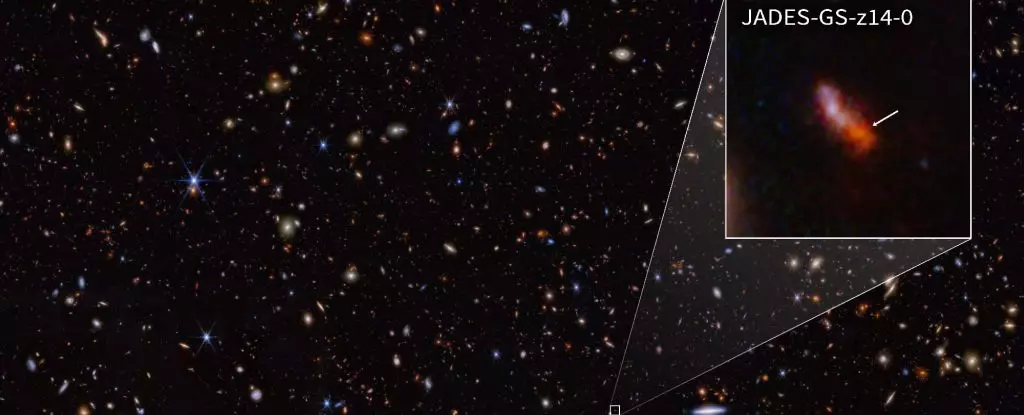A recently discovered galaxy, named JADES-GS-z14-0, has shattered previous records by being the earliest seen galaxy to date. This discovery poses a significant challenge to our current understanding of galaxy formation, as it is observed to be gleaming brightly in the early Universe, less than 300 million years after the Big Bang. Another discovery, JADES-GS-z14-1, has also been confirmed to be nearly as distant as JADES-GS-z14-0. This newfound data is described as “unambiguous” by astronomers, hinting at a possible need for a reevaluation of the Cosmic Dawn period.
The observation of JADES-GS-z14-0 was made possible by NIRSpec in January of 2024, and the resulting spectrum analysis showed clear evidence that the galaxy has a redshift of 14.32. This finding breaks the previous record for the most distant galaxy observed. The galaxy itself is over 1,600 light-years across, indicating that the light emitted is primarily from young stars rather than a supermassive black hole. The sheer amount of starlight suggests that the galaxy is hundreds of millions of times the mass of the Sun, raising questions about how such a massive and bright galaxy could form in less than 300 million years.
Several scientific papers have been written on the subject, with one recently published in Nature and two others awaiting peer review on arXiv. All three papers reach the same conclusion: JADES-GS-z14-0 represents a significant datapoint that challenges our current understanding of the formation of the early Universe. The Cosmic Dawn, a period about a billion years after the Big Bang, has been shrouded in mystery due to the presence of neutral hydrogen that scattered light, obstructing visibility. However, with advancements like the James Webb Space Telescope (JWST) and its infrared capabilities, we are beginning to unravel this mysterious era.
Infrared radiation has proven to be crucial in studying the early Universe, as it can penetrate dense media where other forms of light cannot. The JWST’s Advanced Deep Extragalactic Survey (JADES) aims to explore the first 650 million years after the Big Bang, uncovering unexpected findings such as the early appearance of large celestial objects. The discovery of JADES-GS-z14-0 challenges previous assumptions about the timeline for the formation of galaxies and supermassive black holes, highlighting the need for a reassessment of our current models.
The presence of heavy elements like dust and oxygen in JADES-GS-z14-0 suggests the existence of multiple generations of massive stars that have lived and died within a relatively short timeframe after the Big Bang. This revelation contradicts previous expectations and calls into question the traditional understanding of galaxy formation. The findings point to the emergence of large, bright galaxies much earlier in the Cosmic Dawn than previously thought possible, indicating a need for a paradigm shift in our comprehension of the early Universe.
Overall, the discovery of JADES-GS-z14-0 represents a significant leap forward in our understanding of galaxy formation and the early Universe. By challenging existing models and prompting further research, this newfound galaxy opens doors to new possibilities and insights into the cosmic evolution that shaped the universe as we know it. Astronomers are now faced with the task of reevaluating their theories and expanding their knowledge to incorporate the groundbreaking discoveries made possible by advancements in technology and observation techniques.


Leave a Reply